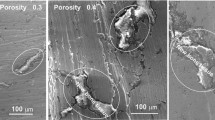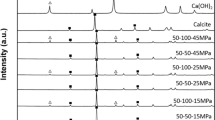Abstract
The interconnections in a porous biomaterial are the pathways between the pores. They conduct cells and vessels between pores. Thus they favour bone ingrowth inside ceramics. The aim of our study was to determine the effect on bone ingrowth of interconnections in two ceramics: hydroxyapatite (HA) and β-tricalcium phosphate (β-TCP) with the same porosity of about 50% and a mean pores size of 100–300 μm and a mean interconnection size of 30–100 μm. In vitro, four discs for osteoblast culture were studied after 14 and 28 days of incubation. The results show that human osteoblasts can penetrate interconnections over 20 μm in size, and colonize and proliferate inside macropores, but the most favourable size is over 40 μm. In vivo, eight cylinders were implanted in the middle shaft of both rabbit femurs for 12 or 24 weeks. The histomorphometric results show that interconnections in porous ceramics favour bone ingrowth inside the macropores. In the HA group the rate of calcification and bone ingrowth do not differ, and chondroid tissue is observed inside pores. But in β-TCP, the calcification rate and the bone ingrowth increased significantly. At week 12 significant correlation between new bone ingrowth and the size of the interconnections is observed between new bone ingrowth and the density of pores. In conclusion we notice that in vivo a 20 μm interconnection size only allows cell penetration and chondroid tissue formation; however the size of the interconnections must be over 50 μm to favour new bone ingrowth inside the pores. We propose the concept of “interconnection density” which expresses the quantity of links between pores of porous materials. It assures cell proliferation and differentiation with blood circulation and extracellular liquid exchange. In resorbable materials, pore density and interconnection density are more important than their size, contrary to unresorbable materials in which the sizes and the densities are equally important. © 1999 Kluwer Academic Publishers
Similar content being viewed by others
References
P. S. Eggli, W. MÑller and R. K. Schenk, Clin. Orthop. Rel. Res. 232 (1988) 127.
J. KÑhne, R. Bartl, B. Frisch, C. Hammer, V. Jansson and M. Zimmer, Acta Orthop. Scand. 65 (1994) 246.
A. Uchida, S. Nade, E. McCartney and W. Ching, J. Orthop. Res. 3 (1985) 65.
K. Shimazaki and V. Mooney, ibid. 3 (1985) 301.
A. Uchida, S. M. L. Nade, E. R. Mccartney and W. Ching, J. Bone Joint Surg. 66B (1984) 269.
A. M. Parfitt, M. K. Drezner, F. H. Glorieux, J. A. Kanis, H. Malluche, P. J. Meunier and S. M. Ott, J. Bone Min. Res. 2 (1987) 595.
R. Z. Le Geros, J. R. Parsons, G. Daculsi, F. Drissens, D. Lee, S. T. Liu, D. Peterson and M. Walker, New York Acad. Sci. 523 (1988) 268.
E. White and E. C. Shors, Dent. Clin. N. Amer. 30 (1986) 49.
J. J. Klawitter and S. F. Hulbert, J. Biomed. Mater. Res. Symp. 2 (1971) 161.
L. Galois, D. Mainard, K. Bordji, H. Membre, L. Marchal, B. Foliquet, D. Clement and J. P. Delagoutte, in Actualite& s en mate& riau 3 (1990) 361.
Author information
Authors and Affiliations
Rights and permissions
About this article
Cite this article
LU, J.X., FLAUTRE, B., ANSELME, K. et al. Role of interconnections in porous bioceramics on bone recolonization in vitro and in vivo. Journal of Materials Science: Materials in Medicine 10, 111–120 (1999). https://doi.org/10.1023/A:1008973120918
Issue Date:
DOI: https://doi.org/10.1023/A:1008973120918




